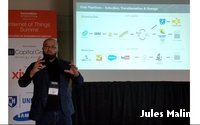GoPro Taps Smartphone Data For New Marketing Insights
- by Chase Martin , September 11, 2016
 A major consumer electronics brand is now collecting and analyzing data to inform business decisions across the entire company.
A major consumer electronics brand is now collecting and analyzing data to inform business decisions across the entire company.
GoPro reached $1 billion before collecting any data from its products in the market, but is now transforming into a data-driven organization, according to Jules Malin, manager of product analytics at GoPro.
Malin, who presented at the Internet of Things Summit in Boston last week, said now that GoPro collects data from its devices, his team is developing analytics systems to turn that data into actionable insights.
Data is not collected from the devices themselves, since they are not connected. Rather, the data is collected through consumers using the GoPro smartphone app, which can control the devices remotely.
Collecting data alone doesn’t add much value, according to Malin.
“Data is not analytics; you need to make sure your data can enable analytics,” he said.
“Just because you’re logging things, doesn’t mean we’re going to be able to make sense of how the product is being used.”
Internally, GoPro is analyzing the data collected from its products at the different levels of device functionality. Malin said this enables the teams to gain highly specific insights about how the products are being used in the market.
“There are three layers we’re looking at: the hardware is triggering events, the firmware is triggering events and the software is triggering events.”
On the product marketing side, Malin said these insights can lead to the marketing team shifting its initiatives to highlight certain features that the analytics identify as frequently used by consumers.
Without the insight, the brand could be blindly pushing certain features that consumers don’t care as much about, according to Malin.
This insight provides similar functionality across the entire company and always starts with a question.
“You should start with a question, like how often are our customers using our products or how are they using them?” he said.
The move toward a data-driven approach has come with varied reactions, Malin said.
“There are three types of people I work with. First, there are those who are highly data driven. Then there are those who use data, but are biased; they want data but are biased in how they use it. And then there are those who have seen the company go to $1 billion without data and don’t think they need it,” Malin said.


